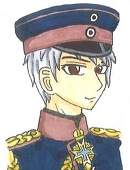
 cylindershako
cylindershakoHetalia © by Hidekaz Himaruya
Königreich Preußen (プロイセン王国)
Preußen (プロイセン)/Gilbert Beilschmidt (ギルベルト・バイルシュミット) with two important men in prusso-german history:
左: Otto von Bismarck (オットー・フォン・ビスマルク).
He was Ministerpräsident (首相) of Prussia from 1862 - 1890 , then Bundeskanzler (連邦首相) of the Norddeutscher Bund (北ドイツ連邦) from 1867 - 1871, and finally german Reichskanzler (ドイツ帝国首相) of the Deutsches Reich (ドイツ国) from 1871 - 1890.
He was the main driving power behind the Deutsche Einigung (ドイツ統一) through the Reichsgründung (foundation of the Empire) in 1871.
Bismarck was politically very cunning and skilled and also coldblooded. Thus, he was among the most influential men in Germany and his traces are of heaviest importance for history.
He also passed the social legislation, the first public health insurance (with the aim of befriending the working class, so they would not turn to the communists).
Due to his very harsh and strict style of politics, he was nicknamed "Eiserner Kanzler" (鉄血宰相).
右: Wilhelm I. (ヴィルヘルム1世).
He was Deutscher Kaiser (ドイツ皇帝 ) und König von Preußen (プロイセン王) from 1861 - 1888. He was König starting from 1861 and additionally the first german Kaiser from 1871 on in personal union (the Reich was a federal state). From 1867 - 1871, he was Präsidium des (Norddeutschen) Bundes (北ドイツ連邦主席).
Under his reign fell many of the most imortant events in german history, however, there was always the "shadow" of Bismarck. He was known for his disagreements with Bismarck and his hesitation towards decisions for change.
E.g., he did not support the idea at first of a unified Germany as he feared to loose Prussia, he cherished above all, within it (so he was an "unwilling emperor" at the start).
However, his fears did not come true as Germany became a federal state (which resulted in his double title/role)).
What both men had in common was heavy stubborness, e.g. the fight over the title "Deutscher Kaiser" by Bismarck or "Kaiser von Deutschland" by Wilhelm I.
In the end, Wilhelm I., like always before, gave in and was proclaimed Kaiser on 18th January 1871 in Versailles (ヴェルサイユ), still during the Franco-Prussian War (普仏戦争).
Preußen and Wilhelm I. wear the Pour-le-Mérite (プール・ル・メリット勲章), one of the highest prussian orders which was possible to award, introduced in 1749 by Friedrich II. (フリードリヒ2世).
Due to it's blue colour, it's also called the "Blauer Max" (ブラウアー・マックス).
Bismarck wears the Eisernes Kreuz (鉄十字), the most popular prusso-german order, introduced in the Befreiungskriege (解放戦争) in 1813 by Friedrich Wilhelm III (フリードリヒ・ヴィルヘルム3世).
(there were three Deutscher Kaiser (and König von Preußen in personal union):
- Wilhelm I. (ヴィルヘルム1世, 1871 - 1888)
- Friedrich III. (フリードリヒ3世, 1888, died of laryngeal cancer after just 99 days of reign)
- Wilhelm II. (ヴィルヘルム2世, 1888 - 1918, had to resign due to Novemberrevolution (ドイツ革命 (11月)) following the First World War(第一次世界大戦)))
2016-02-16 00:26:44 +0000